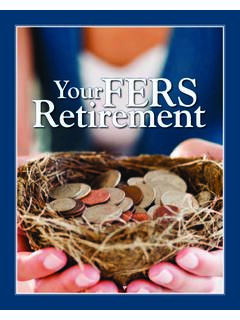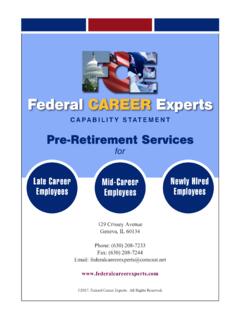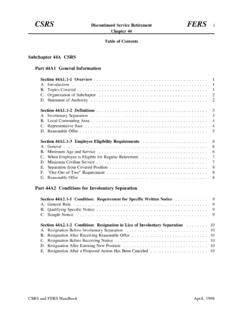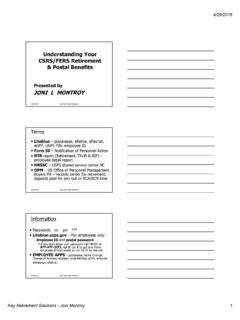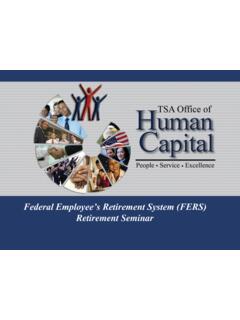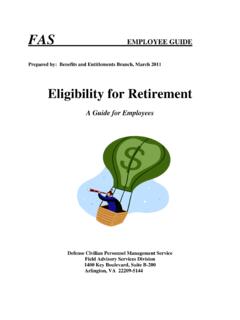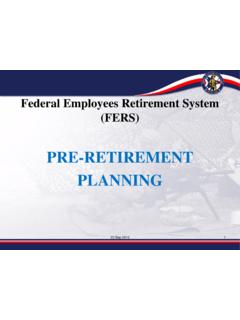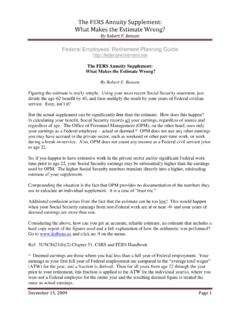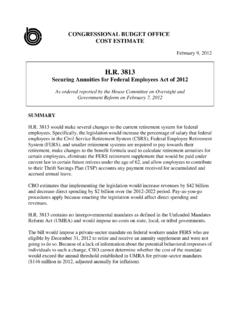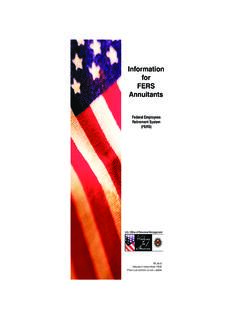Transcription of Answers to 50 Most Common Questions Asked by - 1105 …
1 50 most Common QuestionsAnswers toAsked by Federal Employees FederalDAILY Answer BookAnswers to the 50 most common questions asked by FederAl eMployees2table of ContentsCivil Service Retirement System (CSRS) ..3 CSRS Offset ..5 Federal Employees Retirement System (FERS) ..7 Deposits and Redeposits ..9 Survivor Benefits ..10 Thrift Savings Plan ..12 Social Security and the FERS Retirement annuity Supplement ..14 Medicare and FEHBP ..17 Health, Life, Long-Term Care, Dental and Vision Insurance; HSAs and HCFSAs ..18 CopyriGht notiCe 2012 All rights reserved. No part of this publication may be reproduced, stored in a retrieval system, transmitted in any form or by any means (electronic, electric, mechanical, photocopying, recording, or otherwise) without the prior permission of the copyright inForMAtionTo purchase a license authorizing you to distribute this publication, please call (800) 989-3363 or e-mail have attempted to compile information that is accurate and current as possible.
2 Federal policies laws, regulations, statistics, and addresses continually change; therefore, no warranties are made as to the accuracy or completeness of the information in this by:1105 Government Information Group8609 Westwood Center Drive, Suite 500 Vienna, VA 22183 Contact Information:Customer Service: (800) 989-3363 Fax: (818) 487-4550E-mail: to the 50 most common questions asked by FederAl eMployees3 Civil service retirement system (Csrs) 1. Q. I currently receive both my CSRS Offset annuity and my deceased husband s survivor annuity . If something happens to me, can our son receive the survivor annuity or my CSRS offset annuity ? A. Unless your son is disabled and totally dependent on you, he is not entitled to an annuity upon your death. If he is disabled, then he should have been listed in your spouse s retirement paperwork as a disabled/dependent adult child. If he has been listed as such,then he may be entitled to a survivor annuity upon your death.
3 Also, if he became disabled after adulthood (age 18), then he is not eligible for a survivor annuity under any Q. While I was in college, I worked during the summers of 1974, 1975 and 1976 for a total of nine months as a civilian at a local Army facility. The employer was the Department of the Army, Civilian Personnel Office. After I graduated from college, I started working as a CSRS-covered employee for the Social Security Administration, where I am still employed. I was wondering whether my temporary time which was subject to federal and state income taxes and Social Security/Medicare Part A payroll taxes, although I did not contribute the 7 percent of my salary to the Civil Service Retirement and Disability Fund could be used to increase my CSRS time. In other words, can I add the nine months of temporary federal service to my full-time federal service time? A. Assuming you entered federal service as a permanent full-time or part-time CSRS-covered employee before Oct.
4 1, 1982, you have automatically received credit for both retirement eligibility and CSRS annuity computation purposes resulting from your temporary time totaling nine months at the Army facility. But because you did not contribute to the Civil Service Retirement and Disability Fund during those nine months, you owe a deposit for that time. The deposit is equal to 7 percent of your total salary plus interest charges. If you do not make your deposit in full by the time you retire, you will still get credit for your temporary time. However, your CSRS annuity will be reduced by 10 percent of the deposit due. For more information about the deposit and how the required deposit is calculated, speak to your retirement specialist in your personnel or human resources Q. I am a CSRS employee and plan to retire at the end of 2013. I am trying to determine the best day to retire. Should I retire on Dec. 28, 2013 (Saturday - the end of pay period 26), Dec.
5 31, 2013 (Tuesday), or Jan. 3, 2014 (Friday)? Or is there any difference other than the additional days of pay I would receive for working a few days longer after the end of pay period 26? A. Whether you retire Dec. 28, 2013 (you want to retire on a Saturday, which is the end of a pay period for most employees), or Dec. 31, 2013, or Jan. 3, 2014, your first CSRS annuity check will be dated Feb. 1, 2014, and you would be eligible to receive 11/12 of the cost-of-living adjustment taking effect in January 2015 (assuming there is a COLA taking effect in January 2015). However, by retiring Dec. 31, 2013, or Jan. 3, 2014, you will Answers to the 50 most common questions asked by FederAl eMployees4not accrue any annual or sick leave hours for the last pay period of leave year 2013. This is because you are retiring in the middle of a pay period. If you were to retire on Dec. 31, 2013, you would get paid for Dec.
6 30 and Dec. 31. If you were to retire Jan. 3, 2014, then you would get paid for the first week of the last pay period (Dec. 30-Jan. 3, which includes the Jan. 1 federal holiday). But also keep in mind that if you were to retire on Jan. 3, 2014, then you will receive 27/30 of the first CSRS annuity check dated Feb. 1, 2014, whereas if you were to retire Dec. 28 or Dec. 31, 2013, then you will be eligible to receive a full CSRS annuity check dated Feb. 1, 2014. 4. Q. I am a CSRS employee and hope to retire soon. My husband and I have agreed that we will reduce his CSRS survivor annuity to the very minimum in order to retain Federal Employees Health Benefits Program (FEHBP) health insurance coverage in the event I predecease him. In looking over form SF 2801 Section F to elect the amount of the survivor annuity , I am unable to figure out how much to enter in Section F #2. Do I just enter a dollar amount on the blank line, and how small can it be for my husband to retain the FEHBP health insurance benefit?
7 A. First, to give your husband a reduced CSRS survivor annuity , you must complete Form SF 2801, Section F #2. You must choose a dollar amount that your husband will receive in the event you predecease him. In choosing this dollar amount, you want to make sure he has a sufficient monthly annuity to pay his FEHBP health insurance premium ( self only coverage). Suppose in 2012 the most expensive self only FEHBP monthly premium that an annuitant or survivor annuitant pays is $300 a month. You should add another $100 to that because FEHBP premiums are increasing annually at a much faster rate compared to CSRS annuity COLAs. Therefore, you want a survivor CSRS annuity equal to $400 a month or $4,800 a year. The amount that you must put in Section F #2 is 55% of ?. The number you should put in Section F #2 is therefore $8, (55% of $8, equals $4,800). Finally, you must complete SF 2801-2 (Spouse s Consent to Survivor Election), which your husband will have to sign, date and have notarized.
8 5. Q. I have been told that a CSRS-covered employee who has the minimum years of service and age in this case, around 34 years of service and age 56, respectively cannot apply for a disability retirement due to the fact that one is already eligible for a normal or regular retirement. However, someone else said that an employee can retire on disability if he does so prior to his 62nd birthday. Which is true? Also, would there be any advantage to opting for a CSRS disability retirement rather than a normal or regular retirement? I do know that there are no tax advantages with a disability retirement as some people claim. However, I want to ask if there are any other advantages with a disability retirement. A. If a CSRS employee has 34 years of service and is at least 55 years old, he or she is eligible to retire under the regular or normal CSRS retirement rules. One would be better off retiring under the normal retirement rules rather than going out under a disability retirement because one could work with no restrictions, earning as much as one wants without losing any of the CSRS annuity .
9 On the other hand, an individual who retires under a disability retirement would be restricted as far as how much one could work and earn without losing any of the CSRS disability to the 50 most common questions asked by FederAl eMployees5 6. Q. What is a CSRS deferred retirement and what does it mean for an employee who chooses it? A. A deferred retirement under CSRS is an option for a CSRS- or CSRS Offset-covered employee with at least five years of service who leaves government service before being eligible to retire. To be eligible for a deferred retirement, the employee does not withdraw his or her CSRS retirement contributions (approximately 7 percent of after-tax wages) made during his or her years of service. In that case, the individual is entitled to a deferred CSRS annuity starting no earlier than the month of his or her 62nd birthday. The individual would also permanently lose health insurance (FEHBP) and life insurance (FEGLI) benefits at the time of departure from federal offset7.
10 Q. If one acquires 30 years of Social Security credits outside federal service and is covered by CSRS Offset, can that individual receive Social Security retirement benefits without being subject to the Windfall Elimination Provision (WEP)? Is there any way of avoiding the WEP? A. To answer this question , one has to distinguish between the Social Security retirement benefit a CSRS Offset employee earned outside federal service (assuming the employee has earned at least 40 Social Security credits outside of federal service) and the Social Security retirement benefit the individual earned as a CSRS Offset employee. The CSRS annuity will be offset either when the individual is age 62 if he or she retired before age 62 or at the time of retirement if the individual retired after age 62 by the amount of Social Security the individual earned as a CSRS Offset employee. This Social Security is not subject to the WEP.
